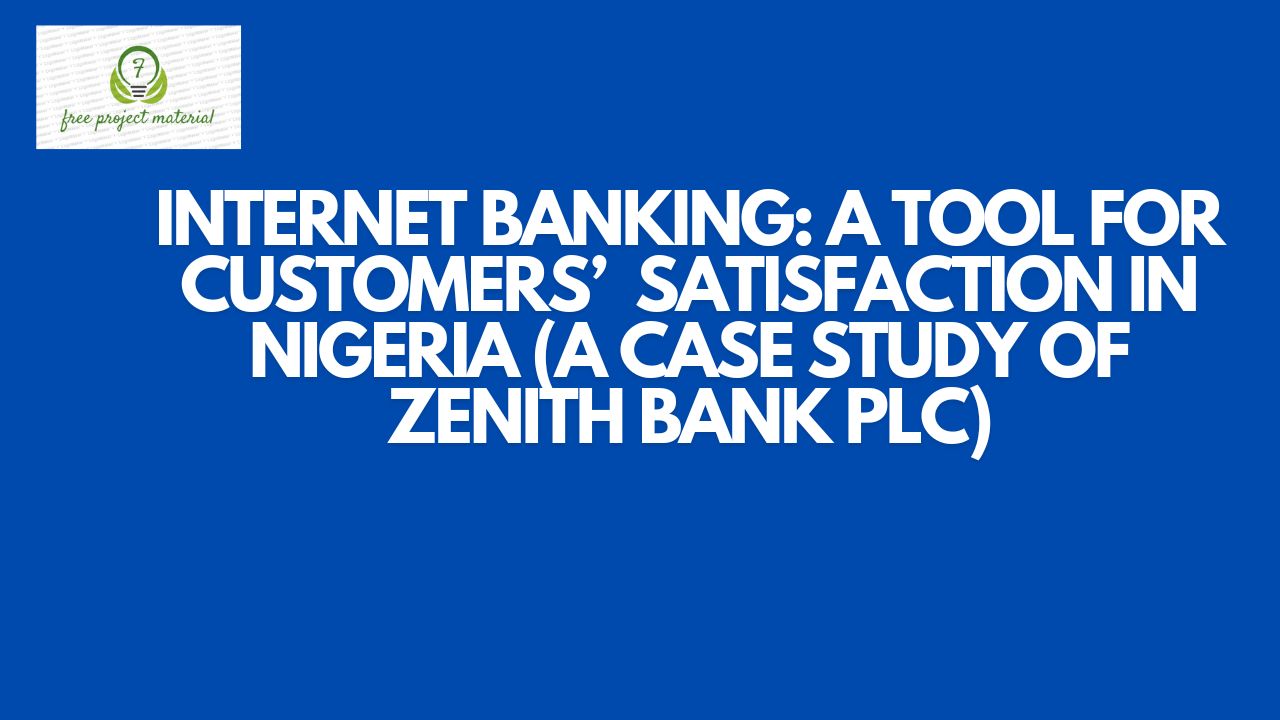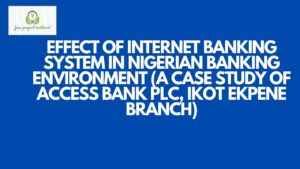ABSTRACT
Internet Bank: A Tool for Customers’ Satisfaction in Nigeria a case study of Zenith Bank Plc. The study adopted the research methodology while Taro Yamane’s formula sampling was used to select (32) respondents as ample size for the study. Instrument of data collections was self-developed questionnaire and the questionnaire forms were personally administered. Data were analyzed using simple percentages and frequency tables. The study revealed that; The importance of internet banking services on the operation of Zenith Bank Plc are; it drives the economy, it eliminate the barriers of distance/time and provides continual productivity and it makes transfer and sending of money easier, the different types of internet banking services used in Zenith Bank Plc are telephone banking, personal computer banking and mobile banking, the impacts of internet banking on customers’ satisfaction in Zenith Plc are; improved services to customers, improved customer services and reliability of transaction, the problems encountered by Zenith Bank Plc since the adoption of internet banking are; infrastructure deficit, low rate of literacy and system operational risk and the ways of reducing the problems faced by Zenith Bank Plc in adopting internet banking are; through reduction in charges and tariff, through effective networking of bank services and through adequate and well-functioning infrastructural facilities. The study recommends that; Banks should ensure that in the use of internet, customer data are not used for purposes beyond which they are specially allowed or beyond which customers have authorized and banks need to design proper customer identification and screening techniques, develop audit trails, and conduct periodic compliance reviews, frame policies and procedures to sport and report suspicious activities in internet transactions to NDLEA and CBN.
LIST OF TABLES
PAGES
Table 4.2.1: Responses to Research Question One – – 38
Table 4.2.2: Responses to Research Question Two – – 40
Table 4.2.3: Responses to Research Question Three – 41
Table 4.2.4: Responses to Research Question Four – 43
Table 4.2.5: Responses to Research Question Five – 44
TABLE OF CONTENTS
PAGES
Title Page – – – – – – – – i
Declaration – – – – – – – – – ii
Certification – – – – – – – – iii
Dedication – – – – – – – – – iv
Acknowledgements – – – – – – – v
Abstract – – – – – – – – – vii
List of Tables – – – – – – – – viii
Table of Contents – – – – – – – ix
CHAPTER ONE
INTRODUCTION
1.1 Background of the Study – – – – – 1
1.2 Statement of the Problem – – – – – 4
1.3 Objectives of the Study – – – – – – 5
1.4 Research Questions – – – – – – 6
1.5 Significance of the Study – – – – – 7
1.6 Scope and Limitations of the Study – – – – 8
1.7 Organization of the Study – – – – – 9
1.8 Definition of Terms – – – – – – 10
CHAPTER TWO
REVIEW OF RELATED LITERATURE
2.1 Introduction – — – – – – – 13
2.2 Concept of Internet Banking – – – – – 15
2.3 Types of Internet Banking – – – – – 18
2.4 Impact of Internet Banking on Customers’ Satisfaction – 20
2.5 Internet Banking Products – – – – – 25
2.6 Benefits of Internet Banking – – – – – 25
2.7 Problems of Internet Banking – – – – 28
2.8 Solution to the Problems of Internet Banking – – 31
2.9 Theoretical Framework – – – – – – 32
2.10 Empirical Review – – – – – – – 34
2.11 Summary of Related Literature – – – – 38
2.12 Research Gap – – – – – – – 40
CHAPTER THREE
RESEARCH METHODOLOGY
3.1 Research Design – – – – – – – 41
3.2 Area of the Study – – – – – – 41
3.3 Population of the Study – – – – – 41
3.4 Sample and Sampling Techniques – – – – 42
3.5 Source and Nature of Data – – – – – 43
3.6 Instrument and Method of Data Collection – – 43
3.7 Data Analysis Technique – – – – – 44
3.8 Empirical Specification of Model – – – – 44
CHAPTER FOUR
DATA PRESENTATION, ANALYSIS AND INTERPRETATION
4.1 Introduction – – – – – – – 45
4.2 Data Presentation and Analysis of Data – – – 45
4.3 Discussion of Findings – – – – – – 53
CHAPTER FIVE
FINDINGS, CONCLUSION AND RECOMMENDATIONS
5.1 Findings – – – – – – – – 56
5.2 Conclusion – – – – – – – – 57
5.3 Recommendations – – – – – – 58
5.4 Implication of Findings – – – – – – 59
5.5 Contribution to Knowledge – – – – – 59
5.6 Suggestion for Further Studies – – – – 60
References
Appendix
CHAPTER ONE
INTRODUCTION
1.1 BACKGROUND OF THE STUDY
Internet banking is a banking service in which funds are transferred through an exchange of internet signals over a network connecting financial institutions rather than the exchange of cash, paper and cheques. Internet banking is a process of transacting banking operations using the internet. It is a process of using electronic devices in carrying out banking operations.
Internet banking does away with most visits to the bank. It is a state-of-the-art-service that is just beginning to take off among banking customers. Indeed internet banking is a major potential for future development as it allows customers to do most of the things they do at the bank like make balance enquiries, payment, transfer of funds, pay bills over the internet. It also offers banking services outside the normal operating hours. In fact, it has effectively “opened” banks for business twenty-four hours a day, seven days a week (Rubino, 2016).
Internet banking has become increasingly prevalent, employed by financial institutions to reduce cost associated with having personnel, serve customers physically, shorten processing period increase speed, improve the flexibility of business transactions and provide better services for all (Shin and Fang, 2015). It is expected that with the provision of internet banking by the Deposit Money Banks to customers, the quality of services rendered to customers would have drastically improved.
Although, banks and their employees claim that e-banking has improved the quality of their customer services tremendously, customers still complain about the quality of services rendered to them. The customers still believe that there is a lot to be done, if customers’ satisfaction is to be enhanced. According to the customers, they have not really enjoyed the benefit of e-banking, because they still spend hours in the banks for simple counter based transactions like deposit, cash transfer and even cash withdrawal. Despite the provision of internet banking, there are lots of customer traffic or patronage in most of the Deposit Money Banks.
Zenith Bank being one of the Deposit Money Banks in Nigeria is under the supervision and regulation of the Central Bank of Nigeria (CBN). It is also one of the financial institutions in the country. According to Zenith Bank Annual Report (2019), the Bank was established and incorporated as a private limited liability company on 3rd May, 1990. It received its Deposit Money Banking License on 20th June, 1990 and commenced operation on 16th July, 1990. Zenith Bank engages in the provision of Universal Banking Services (UBS) to corporate, commercial and individual customers. The bank provides such banking services, savings and current accounts, treasury and financial services like investment banking, equipment leasing, trade financing, fund management, import and export financing, etc. The shareholders’ base of Zenith Bank is over 10 million, including the wide acceptability of the Zenith Bank with over 250 branches and business offices nationwide.
1.2 STATEMENT OF THE PROBLEM
Internet banking system is a driving force that is changing the landscape of the banking industry fundamentally, especially towards a more competitive industry. The following issues and problems constitute part of the operating environment which this research intends to address.
The vulnerability of banks to potential risk of virus attacks; unauthorized access, fraudulent transactions and theft on adoption of internet banking system in the Nigerian environment. The adoption of internet banking in the rural areas of Nigeria will have negative and positive effects on the customers residing there. The introduction of internet banking will definitely lead to mass unemployment since manpower will be replaced by machines.
The problem of exclusion of the old and the poor people in the society who do not have the knowledge of computer or internet banking in accessing financial services and unavailability of the branch network in rural areas relative to the development.
The problem of insecurity and congestion of internet; the existing business environment also poses some challenges to the smooth operation of internet banking in Nigeria which are the epileptic power supply, dominance of cash transactions in the economy and the low level of awareness among Nigerians. This study therefore examines internet banking: a tool for customers’ satisfaction in Nigeria, a case study of Zenith Bank Plc.
1.3 OBJECTIVES OF THE STUDY
The objectives of this research work include the following:
- To examine the importance of internet banking services on the operation of Zenith Bank Plc.
- To examine the different types of internet banking services used in Zenith Bank Plc.
- To examine the impact of internet banking on customers’ satisfaction in Zenith Bank Plc.
- To determine the problems encountered by Zenith Bank Plc since the adoption of internet banking.
- To examine the ways of reducing the problems faced by Zenith Bank Plc in adopting internet banking.
1.4 RESEARCH QUESTIONS
- What are the importance of internet banking services on the operation of Zenith Bank Plc?
- What are the different types of internet banking services used in Zenith Bank Plc?
- What are the impacts of internet banking on customers’ satisfaction in Zenith Bank Plc?
- What are the problems encountered by Zenith Bank Plc since the adoption of internet banking?
- What are the ways of reducing the problems faced by Zenith Bank Plc in adopting internet banking?
1.5 Significance of the Study
This study will be meaningful to the well informed reader to see the relevance of internet banking system to a large extent; it will provide a basis for policy guidelines. It will provide the basis for policy guidelines, it will be of benefit to students as it will provide an additional literature to the existing ones on the need of internet banking system as this will serve as a foundation for subsequent researchers on this or related problems.
The findings of this study will be very useful to Deposit Money Banks, bank customers, the Central Bank, Ministry of Commerce and Industry and the society. The findings of this study would enable Deposit Money Banks, employees and employers to identify the problems confronting customers in obtaining effective and efficient customer services through internet banking and how to eliminate or at least reduce such problems. This is because today’s customers would continue to patronize only the banks that would be most conversant to them in terms of easy transaction.
Again, the Deposit Money Banks as the hub of the nation’s economy would benefit from this study as the study would enable them understand how to impress and retain their customers by providing the relevant and current information technology of internet banking services in their banks.
The Deposit Money Banks customers would benefit from the findings of the work as the study would reveal the current component of internet banking, and how internet banking customers services could be used to facilitate easy and better banking operations.
Finally, the findings of this study would also be useful to students and researchers who may be interested in carrying out further research in this or related topic.
1.6 Scope and Limitations of the Study
The scope of this research will be limited to the Nigerian Banking environment with emphases on Zenith Bank Plc. The work examines internet banking: a tool for customers’ satisfaction in Nigeria, a case study of Zenith Bank Plc.
The study was constrained by
- Financial difficulties which are a major constraint in any research work
- Time constraint: There was not enough time to conduct an enormous research.
- Environmental constraint: the environment in which the research work was written is a restricted area and so the researcher was faced with the problems of examination and other extra-curricular activities carried out in the school.
1.7 ORGANIZATION OF THE STUDY
The research work is organized into five chapters.
Chapter one focused on the background of the study, statement of the problem, research questions, significance of the study, scope and limitations of the study, organization of the study and definition of terms.
Chapter two dealt with the review of related literature.
Chapter three presented the research methodology which is made up of the introduction, the design of the study, area of the study, population of the study, sample and sampling techniques, method of data collection and data analysis techniques.
Chapter four highlighted data presentation, analysis and interpretation, while chapter five capped the research with the findings, conclusion and recommendations of the study.
1.8 DEFINITION OF TERMS
Internet Banking: Refers to a quick and easy way to access one’s account through the internet.
Customer: This is a person that undertake money transaction in the bank. This can be paying or in withdrawing money.
Customer’s Satisfaction: This means meeting the needs of the customers because it is the customer who creates demand for goods and services.
Information Technology (IT): Is the study and the use of electronic process and equipment to store information of all kinds, including words, number, pictures and abbreviation for information technology.
WAN: wide areas network. It is automated systems in which computers in different places are connected, usually over a large area.
LAN: local area network for communication by computer within a large building.
On-line: controlled by or connected to a computer or to the internet.
Hyper-Link: Refers to a place in electronic documents on a computer that link to another electronic document.
Globalization: Is a world trade or an act of looking for information in a database or network.
Network: computing a number of computers and other devices that are connected together so that equipment and information can be shared, the office network allows users to share files and software.



